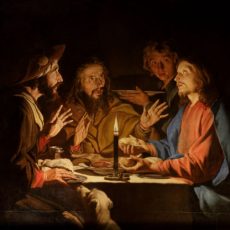A quick note about today’s Gospel… The two disciples on the road to Emmaus with Jesus. Jesus becomes recognizable to them when he “breaks the bread,” and then he vanishes. Jesus has instituted the Eucharist in order to be with us, wherever we are, all around the world, on whatever road. He comes to us now in Holy Communion. He breaks the bread, gives it to them, and then vanishes. What is left is the Eucharist and the believers, the recipients of the Eucharist. We see Christ in the Eucharist, and we also now see Christ in one another. He has become part of us, united with us, through the Eucharist. This also helps explain why Jesus told Mary Magdalene “not to cling to him” in an earlier Easter story, when she saw the risen Lord. How peculiar it was for him to say not to cling to him because he hadn’t yet risen to his Father. After he rises to his Father, he will come to us in a new way, a Eucharistic way. After that, we can “cling to him,” and him to us, because he comes to us in the Eucharist. He allows himself to be placed on our hand, on our tongue, and to become part of us, so that we can carry him around with us, inside of us. He will now be on every road, to every city, not only on the road to Emaus, through the Eucharistic “bread.”
Jesus
Sunday – Ordinary Time – Week 22 – Year A

Like Peter we sometimes ask why the cross is necessary. Why did he allow his Son to experience the rejection and pain of the Cross? This was Peter’s question. He didn’t want Jesus to experience suffering. And sometimes we don’t want to experience it ourselves. Today our Lord asks us to accept the Cross; he says that new life for us will come from it. We also know that the Cross is God’s highest expression of his love for us. We can begin to understand this through an image of mother or father with their 1 year old.


